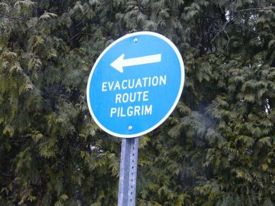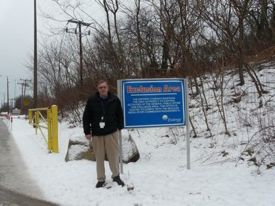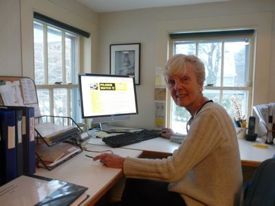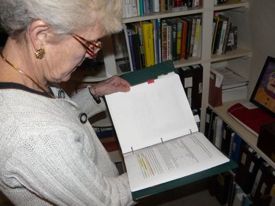Waste Not, Want Not
Air Date: Week of February 26, 2010

President Obama’s decision to cut federal funds for the Yucca Nuclear Waste Repository leaves operators of the nation’s reactors holding more than 120 million pounds of high level waste. Federal officials say that the waste is safe, but critics say spent fuel pools are vulnerable targets for terrorists. Several State Attorneys General are suing to change that. Senior Correspondent Bruce Gellerman investigates the Pilgrim reactor in Plymouth, Massachusetts.
Transcript
YOUNG: Vermont just said no to nukes. Vermont’s State Senate blocked a license extension for the aging – and leaking – Vermont Yankee nuclear power plant. That comes just days after President Obama announced billions of federal dollars to build reactors. The president wants a new generation of nuclear plants, but as the Vermont vote shows, old problems still plague the industry. One of the biggest problems is what to do with nuclear waste.
The Obama administration’s budget would eliminate funding for Yucca Mountain. That Nevada site for high-level nuclear waste was supposed to start taking spent fuel from commercial reactors in 1998. But Yucca never opened and very likely never will. Which means, for the indefinite future the radioactive waste from nuclear plants will have to be stored on site. Critics say that generates a whole host of concerns. Living on Earth’s senior correspondent Bruce Gellerman reports.
GELLERMAN: The Pilgrim Nuclear Power Plant is 40 miles south of Boston just down the coast from Plymouth Rock. It’s one of the 104 commercial reactors operating in the United States and virtually identical to the Vermont Yankee plant.
[ENVIRONMENT AMBIENCE AROUND PLANT]
GELLERMAN: As you might expect security here is tight. There are concrete barriers and surveillance cameras. Security measures seen and unseen. Guards at the entrance wear combat fatigues, carry guns and extra clips for their automatic weapons and masks to filter radiation just in case.
TARANTINO: Security is a major factor in our lives here.
GELLERMAN: Dave Tarantino is head of public affairs at Pilgrim.
[SOUND OF CAR DOOR CLOSING]
GELLERMAN: We meet at the front gate of the power plant, get into Tarantino’s company truck, and talk about Pilgrim.
[SOUND OF CAR DOOR CLOSING]
GELLERMAN: The plant is owned by Entergy, the second largest generator of nuclear power in the United States, and Pilgrim is the sixth largest reactor in the nation.
TARANTINO: Interestingly right now we’re in the middle of a 20 million dollar upgrade and a new ring of security.
GELLERMAN: Tarantino doesn’t go into details – they’re classified. Behind the fence and barricades the Pilgrim nuclear reactor has been generating electricity since 1972 – enough energy to replace 10 million barrels of oil a year.
TARANTINO: Unlike most power generation – where does their waste go? If we’re looking at coal, gas – where does it go? It goes into the air doesn’t it? Ours isn’t in the air. Ours is not in the environment. Ours is safely stored. We don’t contribute to greenhouse gases. So there’s a lot of positives and it’s a very small amount of waste for all the electricity we’ve generated.

David Tarantino, head of public affairs at Pilgrim. (Photo: Bruce Gellerman)
LAMPERT: When we moved here a few people said to me, you know there is a nuclear plant there. And I thought: there is?
GELLERMAN: Since 1986, Lampert and her husband have lived in a rambling colonial home 6 miles upwind across the bay from the nuclear plant. But it wasn’t operating back then. The Nuclear Regulatory Commission shut Pilgrim down for safety violations. Three years and half a billion dollars of improvements later, the NRC allowed Pilgrim to re-open.
[LAMPERT WALKING UP STEPS]
GELLERMAN: That’s when Mary Lampert began to take notice…
LAMPERT: When I had a life this used to be a closet.
[GELLERMAN LAUGHS]
GELLERMAN: Today, this former closet is the office for Pilgrim Watch, an organization Lampert founded 10 years ago.
LAMPERT: This is where I work.
GELLERMAN: 68-year-old Mary Lampert volunteers 50 hours a week watching Pilgrim, which you can see just over the top of her computer monitor.

Mary Lampert, founder of PilgrimWatch.org. (Photo: Bruce Gellerman)
GELLERMAN: Over the years Lampert has gotten the town to put in emergency evacuation signs and stock potassium iodide pills against radiation, and her thinking about Pilgrim has evolved:
GELLERMAN: So you’re not saying “no nukes” at this point?
LAMPERT: If I had my preference I know there are safer and cheaper ways to turn the lights on. I know that. But I know that’s not doable in this environment. So my goal is simply: what can be done to make it safer?
GELLERMAN: Lampert’s number one concern: the spent fuel. The intensely hot and high-level radioactive waste produced by Pilgrim’s reactor.
TARANTINO: All of the spent fuel that we’ve used since 1972 currently resides in the spent fuel pool.
GELLERMAN: Spokesman Dave Tarantino says Pilgrim, like all nuclear plants in the United States, uses a pool to cool down used fuel assembly rods when they come out of the reactor. When Pilgrim was built four decades ago spent fuel was supposed to stay in the pool for about a year then get reprocessed into new fuel. But the U.S halted reprocessing in 1977, so nuclear plants have had to pack and re-rack the radioactive rods closer and closer together. Pilgrim’s pool now contains five times as many spent fuel assemblies than it was originally designed to hold: 38 years worth of high-level radioactive waste.
TARANTINO: It was never intended to be the permanent repository for that, so now the fuel just needs to be stored somewhere.
GELLERMAN: In the future Pilgrim plans to move some of the spent fuel into dry casks – huge cement coffins – and store the casks on site. But waste rods will continue to remain in the densely packed pool. Pilgrim’s pool is 40 feet deep, 30 feet long and 20 feet wide. It’s lined with stainless steel and thick reinforced concrete walls. Most nuclear plants have below ground pools. But at Pilgrim and Vermont Yankee – along with more than 30 other plants in the United States that were designed in the 1960’s – the spent fuel pools are located above the reactor, outside of the primary containment shell.
TARANTINO: And the spent fuel pool is inside secondary containment surrounded by five feet of reinforced concrete with a steel liner.
GELLERMAN: So there is five feet of containment around the entire pool area.
TARANTINO: Except for the top – the top is open.
LAMPERT: The roof is about as sturdy as the roof over our high school gym.
GELLERMAN: Mary Lampert of Pilgrim Watch.
LAMPERT: The amount of radioactivity in that swimming pool on that attic of Pilgrim is about eight times than what’s in the core, in the reactor. What is there to prevent a terrorist from attacking? In a very small private plane, loaded with explosives could target it and that would be the ball game.

Mary Lampert reads an NRC document. (Photo: Bruce Gellerman)
NEWSCASTER: We are following breaking news out of Austin, Texas where the pilot of a small plane slammed into a seven-story building. That building houses offices for the Internal Revenue Services and the CIA.
GELLERMAN: F16 jets scrambled to the scene. It’s a scenario independent nuclear analyst Gordon Thompson has warned could happen at plants with above ground waste pools.
THOMPSON: These facilities are obvious targets. And I’ve described them as radiological weapons awaiting activation by an enemy.
GELLERMAN: Gordon Thompson is executive director of the Institute for Resources and Security Studies. He says if a plane hit a densely packed spent nuclear fuel pool, like the one at Pilgrim, with its roof unprotected, water could drain from the waste pool, and the exposed assembly rods could ignite into an unstoppable fire, sending enormous amounts of radioactivity into the atmosphere.

Gordon Thompson, executive director of the Institute for Resources and Security Studies. (Photo: Bruce Gellerman)
THOMPSON: And this argument has been made at proceedings before the Nuclear Regulatory Commission and they have consistently rejected this argument.
MCINTYRE: Oh, of course the NRC has looked at this in great detail in the immediate aftermath of the 9-11 attacks.
GELLERMAN: David McIntyre is a spokesperson for the Nuclear Regulatory Commission. The NRC licenses and regulates U.S. commercial reactors. McIntyre says there are redundant safety systems and security at each plant has been studied:
MCINTYRE: We believe because the modeling that we did, and the very intensive and of course classified security analyses we did of these facilities that the risk of any fire caused by an accident or a terrorist attack is very low. We believe the high-density storage is safe and there’s no over riding need to change that.

(Photo: Bruce Gellerman)
GELLERMAN: Mary Lampert of Pilgrim Watch.
LAMPERT: And I’m sorry, that’s not what we’re going to do.
GELLERMAN: What Lampert is doing – and so are the Attorneys General from Connecticut, California, Massachusetts and New York – is suing the NRC over the waste pool issue. They seek a review of the classified information the NRC used in its calculations and they want the spent waste pools to be considered when a nuclear plant applies to renew its operating license.
About half the nation’s reactors have already been relicensed, all that have applied to the NRC have been granted 20-year extensions beyond their original 40-year permits to operate. Pilgrim Nuclear Power Plant is one of about a dozen that is seeking renewal, but as the NRC regulations now stand the security of the plant and waste pool cannot be challenged. Again, David McIntyre of the NRC:
MCINTYRE: We look at security 24/7 so we’re not really looking at security during the relicensing because that’s not the appropriate venue for looking at security. We’re looking at security every day for every one of these plants.
GELLERMAN: Today, there is more radioactive waste being stored in spent fuel pools at the nation’s 104 reactors than the Yucca Mountain federal repository was designed to hold.
[SOUND OF CLOCK TICKING]
GELLERMAN: And a clock on the Pilgrim Watch web page ticks off the time to 2012 when that the Pilgrim nuclear power plant’s 40-year operating license is up and space in it’s spent fuel pool is maxed out. For Living on Earth I’m Bruce Gellerman.
[CLOCK SOUNDS CONTINUE]
Links
Living on Earth wants to hear from you!
Living on Earth
62 Calef Highway, Suite 212
Lee, NH 03861
Telephone: 617-287-4121
E-mail: comments@loe.org
Newsletter [Click here]
Donate to Living on Earth!
Living on Earth is an independent media program and relies entirely on contributions from listeners and institutions supporting public service. Please donate now to preserve an independent environmental voice.
NewsletterLiving on Earth offers a weekly delivery of the show's rundown to your mailbox. Sign up for our newsletter today!
 Sailors For The Sea: Be the change you want to sea.
Sailors For The Sea: Be the change you want to sea.
 The Grantham Foundation for the Protection of the Environment: Committed to protecting and improving the health of the global environment.
The Grantham Foundation for the Protection of the Environment: Committed to protecting and improving the health of the global environment.
 Contribute to Living on Earth and receive, as our gift to you, an archival print of one of Mark Seth Lender's extraordinary wildlife photographs. Follow the link to see Mark's current collection of photographs.
Contribute to Living on Earth and receive, as our gift to you, an archival print of one of Mark Seth Lender's extraordinary wildlife photographs. Follow the link to see Mark's current collection of photographs.
 Buy a signed copy of Mark Seth Lender's book Smeagull the Seagull & support Living on Earth
Buy a signed copy of Mark Seth Lender's book Smeagull the Seagull & support Living on Earth

